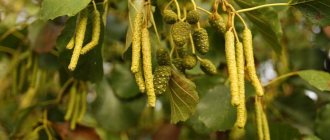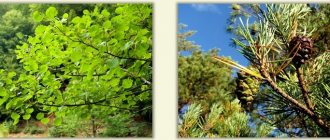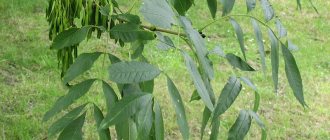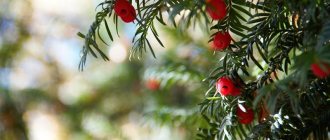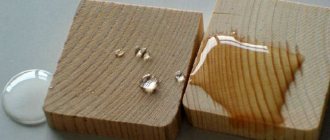- July 14, 2019
- Trees and shrubs
- ROME.
One of the most common types of trees is willow. It is beautiful: thin hanging branches, a powerful trunk, elongated leaves of various colors, fluffy earring-shaped flowers. As you can see in the photo, the willow tree can be incredible. What types of plants exist and what do they look like?
General information
The most common type is a tree with silvery foliage, which is found in parks and on the banks of reservoirs. In Russia, this species is called not only weeping willow, but also willow, vine, and willow.
In nature, there are plants up to thirty meters high with a trunk diameter of 50 centimeters. The further north you go, the lower the willow: here it is represented by a low-growing shrub, up to 30 centimeters high. There is also a herbaceous willow 3 cm high.
Most often, willow is found on the banks of rivers and lakes, but there are also species that grow exclusively on mountain slopes and in semi-desert areas. These plants have a well-developed root system, which is why they are often used to secure the sandy banks of artificial and natural reservoirs.
Willow (photos of the tree are presented in the article) is used to decorate gardens, parks, and in recent years some species have begun to decorate garden plots. The plant looks especially beautiful in garden plots near ponds.
Planting, care and propagation
Once it has been decided which type or variety of willow is suitable in each specific case, it is necessary to study the question of how to plant and care for willow.
Reproduction
Willow reproduces in two ways:
- Seeds;
- By cuttings.
The first method of reproduction is rarely used and is widespread only in wild conditions. The fact is that a willow seed only lives for 1 week and it is quite difficult to find one suitable for planting.
The second method - cuttings - will definitely lead to results. You need to harvest cuttings between seasons, best in November or March. The shoot must already be sufficiently formed (it must be at least 2 years old). The required cutting length is approximately 25 cm.
It is best to plant the cutting first in a greenhouse or in a home pot, wait until the root gets stronger and takes root. In such conditions, the willow must be kept for a year and then planted in open ground. Willow should be planted in the spring, after all the snow has melted.
The seedling can be purchased ready for planting when it has already sprouted. Many people do this because it saves them unnecessary hassle.
Landing
The first thing you need to pay attention to when planting willow is the soil. Almost all varieties of willow do not like dry soil. If the gardener believes that the willow will not take root under the existing conditions, then humus or compost can be added to the soil.
A small hole is dug in the chosen location (it all depends on the type of willow), the earth is loosened and fertilized if necessary. The planted tree must be watered abundantly. Willow grows quickly.
Replanting a willow is not difficult, but if it has a weak root system, then it is better not to do this.
Care
The care that willow needs depends entirely on its variety. But, usually it comes down to three components:
- Watering;
- Fertilizer;
- Trimming.
List of types of care
| Procedure | Detailed description |
| Watering | Moist soil is the key to rapid growth of willow. This is especially worth remembering during dry summers. Most gardeners recommend watering the willow with buckets, or even better, throwing a hose under the willow for a while. In winter, in cold regions, there is usually enough moisture for willow. But, if the winter is dry, then it is better to water the plant during this period. |
| Fertilizer | You can feed the willow with fertilizers as desired. If you see that the willow is not growing or the leaves are quickly withering, then you can fertilize the soil. If everything is fine with willow, then it is better not to use any additional means. |
| Trimming | It is possible to prune some varieties of willows only in the first years of its growth. A willow 15 meters high is quite difficult to prune. If there is such an opportunity, then it is better to do this in spring or early autumn, while it is not yet cold. Willow responds well to pruning. |
goat willow
This is an ornamental tree with hanging branches. The height can be very different, depending on the graft.
The species is light-loving, although it grows well in shaded areas. The ideal landing site is considered to be the shore of a reservoir. Frost-resistant.
The crown is weeping, the leaves are dull green, turning yellow in the fall. The plant blooms in April-May with fluffy golden flowers. The Kilmarnock goat willow (pictured) usually does not grow higher than one and a half meters.
Among the popular varieties of goat willow is Pendula. This is a low ornamental tree that will look ideal in group plantings on the banks of reservoirs. The height of the plant depends on the height of the graft.
Pendula is a light-loving variety with high frost resistance. Grows well on any type of soil with varying degrees of humidity.
The crown is weeping, with dull green leaves. Pendula blooms in autumn with golden flowers. The height of the tree does not exceed 160 centimeters.
Shrub varieties
The most beautiful willows, most often used in landscape gardening, are represented by six species:
- creeping
- purple
- spreading
- gray (ash)
- Siberian
- subozita.
Related article:
What nut crops can be grown on the plot: 4 nuts at your dacha
Each variety includes many varieties and has its own advantages.
Creeping
Creeping willow grows in the form of a compact bush or tree, reaching no more than 1 m (in rare cases, up to 2 m) in height. The crown can grow up to 2 m in diameter, and its shape depends on the variety and growing conditions, but can be created artificially, since the plant tolerates pruning well.
The most popular varieties include:
- Armando - specially bred for use in landscape gardening. It grows no higher than 0.8 m, the crown is up to 1 m. During flowering it is covered with very beautiful pink “seals”. As soon as this period passes, the branches are pruned to form a more luxuriant crown.
- Voothuisen is the most frost-resistant, but only when grown not in standard form. Under a layer of snow it can withstand temperatures down to –29°C. The tree may suffer from severe frost and therefore requires winter shelter.
- Nitida is a dense shrub about 0.6 m high and up to 1 m wide. The slowest growing of all representatives of the crop.
- Ordinary is a medium-height (up to 0.75 m) shrub with a spreading crown, the width of which is 2 times the height of the plant (1.5–1.6 m). It is not capricious in relation to the soil, it tolerates transplantation easily. Very photophilous.
- Silver is the shortest (0.3–0.5 m), but very spreading - the crown grows up to 1 m in diameter. Another difference is the presence of fluff on the leaf plates, which gives them a silvery tint.
Related article:
How to rejuvenate old fruit trees
Silver
All of these varieties, except Voothuisen, have average frost resistance and can withstand temperatures not lower than –25°C. Frosts are especially dangerous for annual shoots, but with prolonged and severe cold weather, a willow bush can die completely.
Purple
Purple bush willow is one of the most popular plants in landscape design, valued for its spherical shape and unusual color. The height of the bush varies between 1–6 m. Long shoots are covered with red-brown bark. During the flowering period, purple catkins form on them, which is how the species got its name.
The lanceolate leaves are blue-green in color. Therefore, the popular second name “red-leaved willow” does not correspond to reality. Only the branches of the plant have a red tint.
Related article:
Decorative plants for the garden
Another advantage of this variety is the ability of the root system to strengthen the soil, which is especially important on the banks of reservoirs. This species grows best on neutral soils, but takes root on any soil.
The most famous varieties:
- Gracilis is a rounded shrub no higher than 1 m with long shoots and small leaves of a bright emerald color.
- Lighthouse - distinguished by erect long branches with narrow leaves.
- Nana is a bush up to 1 m high with a rounded crown with a diameter of up to 2 m. It is the most frost-resistant in this group.
- Pendula is a shrub up to 1.5 m with a weeping crown of unusual light green color. In spring it requires mandatory pruning. Drought resistant.
Purple willow is most often used as an addition to tall plants, giving them a well-groomed, neat appearance.
Related article:
Walnut at the dacha
Spreading
Spreading willow is a low (up to 1 m) shrub with a spreading, wide (up to 4 m) crown, which is formed by flexible branches covered with purple or red-brown bark. This bush species is a slow-growing one. It is resistant to frost and strong winds. Most in demand when decorating rocky hills.
The leaves are even, lanceolate, flat. The upper side is green in color, the lower side is silver, covered with a light edge. Stipules are narrowly lanceolate, rapidly falling, and often completely absent.
During flowering, catkins emit a strong aroma. Therefore, the plant is considered an excellent honey plant.
Gray (ash)
Gray willow is a low shrub with a dense spherical crown. The shoots are thick, but very fragile, abundantly covered with foliage. The surface of the leaf blade has an ash-gray color, which is why the plant got its name.
One of the most moisture-loving representatives of this culture. Ideally, it is planted on the shore of a reservoir. It does not make any special demands on the soil composition and grows well even in swampy peat areas.
Related article:
What is medlar and how is it useful?
The beauty of gray willow is most fully manifested when arranging a hedge. She is not afraid of drastic pruning, so she can be trimmed to get the desired shape.
Siberian (rosmarinolium)
Siberian willow is a spreading shrub with a beautiful crown consisting of numerous thin branches with shoots. It can grow up to 2.5 m, but most often the height of the bush does not exceed 1 m with a crown diameter of 3.5 m.
Prefers light soils. Unpretentious, does not require special care. In landscape gardening it is usually used to build hedges.
This is the smallest-leaved willow of the representatives of this species. Its leaves reach a length of no more than 2 cm and are shaped like rosemary sprigs, which served as the basis for the appearance of the second name - rosemary leaf. When young, the foliage is slightly fuzzy, then becomes glossy. The color also changes - from bright green in summer to yellow in autumn. The leaf turns brown before falling.
Related article:
Planting sea buckthorn seedlings
The advantage of this variety is its absolute unpretentiousness. The shrub grows well in any soil and even in urban conditions with high air pollution. At the same time, it is resistant to frost and can withstand temperatures down to –30⁰С without shelter.
Subozita
Willow angustifolia subosita is the smallest of all bush species: the compact shrub grows to a maximum of 0.5 m, forming a dense spherical crown. Thin straight stems are completely covered with fluff. The bark is green at first, then turns brown. The leaves are elongated, relatively short (up to 3 cm), glossy above, the lower surface is covered with gray-yellow hairs.
The plant is light-loving, not too frost-resistant (down to –23°C) and is afraid of strong winds. Tolerates urban conditions well. There are no special requirements for the composition of the soil, the main thing is that it is sufficiently moist.
Not afraid of a haircut. Sanitary pruning is mandatory, as it requires regular removal of dead parts. It is also advisable to form a standard and crown.
Related article:
What can be planted in September: 7 options for shrubs and trees
purple willow
This is a shrubby species. It has red-brown thin branches. Grows quickly, even on sandy soil. It differs from other shrubs in its high frost resistance and unpretentiousness. The crown is easy to form. Purple willow is used for hedges, as well as in single plantings.
The crown has a spherical shape. The leaves are silvery-green, turning yellowish-green in autumn. Blooms in April-May with elongated flowers. The culture reaches a height of 5 meters with the same crown diameter.
A popular variety of purple willow is Mayak. This is a winter-hardy ornamental shrub variety with thin reddish-pink branches. Prefers to grow in sunny places with moderate soil moisture. The crown of the purple willow Mayak is spherical. The leaves are greenish, with a silvery tint. Blooms with yellow-pink flowers. The lighthouse reaches a height of 3 meters.
Another variety of purple willow is called Nana. This is a shrub with red-brown branches. The variety is not demanding on lighting. In winter it must be protected from the wind. The crown is perfectly formed. Nana is used for single plantings, as well as in compositions, in hedges, and when planting the variety near water bodies. The shape of the crown is very lush, semicircular. The foliage is elongated and narrow. Blooms with greenish flowers. The height of the bush does not exceed one and a half meters.
How to decorate a willow garden?
In gardens and parks, willows are usually traditionally planted on the banks of a reservoir. And this is quite understandable - a natural landscape, a familiar image. But, of course, such a plastic and unusually impressive tree will decorate any corner of the garden, and its crown will protect you from the scorching sun.
Willows, planted at intervals of 1.5-2 meters, form a high hedge, and in two rows - a shady alley. The alley is especially beautiful from the weeping white willow when the trees close their crowns. To do this, already in the second or third year after planting, branches directed towards each other are intertwined at a height of 2.5 to 3 meters or connected using ablation. Ablation is a grafting method used to connect shoots of one or different plants without cutting them.
True, this method requires special skills, so the easiest way is to braid the branches by securing both tops with thin plastic tape. After the closure of the willow branches, a green openwork tunnel is obtained. And if there is no room in the garden for an alley, then you can limit yourself to a green arch at the entrance - just two trees.
READ Acacia tree or bush?
Shrub willows (purple willow, climbing willow, Caspian willow) are a delightful material for hedges. They will shade and at the same time decorate a children's or sports ground. But no less picturesque are the bushes, simply planted in a row or in several clumps along the garden path. And how interesting dwarf or weeping willows look in a rock garden, especially if there is a stream flowing nearby or a small fountain gushes.
However, a lone willow on a wide lawn surrounded by flowering ornamental shrubs or in the company of coniferous plants, whose prickly beauty only benefits from such a contrast, is also impressive.
Entireleaf
A spreading shrub or small tree with unusual hanging branches. The plant is not frost-resistant, which is why it is grown mainly in the southern regions, in Asian countries.
The crown of the whole-leaved willow variety Hakuro Nishiki is round, the leaves are white-pink-green. A distinctive feature is that in the fall they turn pink. The height of the plant and the diameter of the crown do not exceed two meters.
Application
Willow looks great in solitary and group plantings. Dwarf species of this shrub are often used to decorate rockeries and rock gardens. Most varieties withstand pruning well and are often used for making hedges .
Most often, willows are found near bodies of water, where they look especially impressive thanks to the silver-green hue of the leaves, successfully complementing the surface of the water. The big advantage of these plants is their powerful root system, which allows them to be used to strengthen slopes and prevent soil erosion.
Swiss willow
You can see a photo of a tree with silver leaves below.
The Swiss species is classified as dwarf. It grows very slowly and prefers light areas. Does well in fertile, loose soil with high humidity levels.
The look goes perfectly with coniferous plants. It has a round crown and silvery leaves. The height of the bush reaches one meter, but the crown is wide, up to one and a half meters in diameter.
The main pests of willows and measures to combat them
In the general system of measures to increase the productivity of willows on plantations, special attention should be paid to measures to combat diseases and pests. Most often, willow is damaged by caterpillars of various butterflies, leaf beetles and elephant beetles, aphids, flies, as well as the parasitic dodder plant. The Russian, twig and purple willows suffer the most from insects.
- Poplar leaf beetle. The beetle is 10 to 12 mm long, with reddish elytra and bluish-green pronotum and underside of the body. At the top of the elytra there is one black spot.
- Aspen leaf beetle. The appearance and biology of the aspen leaf beetle are similar to those of the poplar leaf beetle. The beetle is slightly smaller in size than the poplar beetle (length from 7 to 10 mm) and does not have black spots on the elytra.
- Willow silkworm. Most often it affects willow. Leaf roller caterpillars roll the tops of the leaves into a dense cocoon and eat the top of the shoot. The shoot bushes, which is why it loses its technical qualities.
- Common willow aphid. Sucks juice from leaves, buds, and young shoots. Gives 10 generations per year.
Spider mite
Spider mite. Appears on the underside of the leaf and sucks out the juice. If the damage is severe, the leaves turn brown and fall off. In summer the mite is greenish-yellow in color and by autumn it turns reddish-orange in color. Overwinters under bark, fallen leaves and in soil (in the adult female stage).
Bindweed. A weed that causes harm to willow plantations, especially in the first year of life. The bindweed wraps around the rod, leaving traces of spirals on the bark and even on the wood, causing the rods to break during operation. Shoot growth stops.
European dodder. Plant parasite. The dodder sends adventitious roots into the wood of the twig, sucking out nutrients. Often the entire bush dies from dodder.
Willow grass. A butterfly from 20 to 25 mm long with white wings. The caterpillars are hairy, yellow-blue in color with red specks.
Mouse-like rodents damage roots and gnaw planted cuttings.
Babylonian view
This willow (the photo of the tree looks incredible) is a spreading tree with very long, hanging branches. The red, green or yellow hues of the branches create a waterfall from the top of the tree to the ground. This variety is highly frost-resistant. Looks beautiful on the banks of a reservoir.
The crown has a round shape. The leaves are long, dark green. The lower part of the plate is gray. It blooms with white-yellow flowers in the form of earrings. The tree grows up to ten meters in height.
Botanical description
Willow is a deciduous tree and is one of the most common types of vegetation in the northern hemisphere. Willow is considered an ancient plant, because some of its species grew on Earth even before the Ice Age. In Russia, willow has several names:
- willow;
- broom;
- willow;
- willows and so on.
Weeping willow or Babylonian willow belongs to woody plants of the Willow family. The lifespan of willow is no more than 100 years.
Wood appearance
The appearance of the willow may vary depending on the species, but we will look at a detailed description of the weeping willow. The height of the average tree is 16-20 meters.
The willow crown consists of long hanging branches. The branches themselves are a brilliant red or yellow-green hue.
The leaves have an oblong shape, they grow up to 10-16 cm in length and up to 2 cm in width. Along their entire length, the leaves have different colors: at the base they are dark green, at the end they are bluish-green, and their edges are grayish.
The weeping willow has what are called catkins, which appear either before or after the leaves appear. Earrings grow on small branches and are ovoid in shape. Their color is yellow-green.
Root system, fruits and flowers
The root system is well developed and can even strengthen the soil. The higher the moisture in the soil, the less developed the root system will be.
Willow seeds are located in a small fruit that has the shape of a box. The seeds are small and covered with slight fluff.
Weeping willow flowers are white and yellow. The tree blooms in late spring or early summer.
Holly willow
Most often seen in pictures is the common willow, or pussy willow. This is a tree or shrub with thin red branches with a pronounced waxy coating that is easily erased. The species is unpretentious and frost-resistant. Prefers to grow near ponds on sandy soil.
The crown of the plant has an oval shape. This willow has leaves (this is clearly visible in the photo) that are elongated and have a greenish tint. Blooms in April. The tree grows up to ten meters in height.
Shock is our way
One of the most interesting and original willows is i. Sakhalin 'Sekka' (S. udensis = S. sachalinensis 'Sekka'). In Japan it is called Dragon Willow. This 3-4 m tall shrub is distinguished by unusual shoots: at the ends they grow together, forming spectacular flat “curls”, thanks to which the plant takes on an absolutely fantastic appearance. And during flowering the impression is even stronger. The catkins of this willow, densely covering the flat shoots, are pink-purple at first, but as they bloom, they become white-golden due to numerous long stamens with yellow anthers. Blooming 'Sekka' turns into a real queen of the garden, so it is better to plant it separately in a prominent place.
creeping willow
This species is a small creeping shrub with very flexible branches. Most often grown in the form of a standard. The Armando variety is grown not only in gardens, but also indoors, on balconies, and greenhouses. The variety is frost-resistant, prefers moist soil, and is light-loving. The tree is widely used to decorate stone gardens, planted near water bodies.
The crown of the crop is spreading, the leaf blade is green on top and silver underneath. Blooms in spring with fluffy pinkish-silver flowers.
The height of the creeping willow does not exceed a meter, and the crown is huge, reaching three meters in diameter, and needs to be shaped.
How many benefits are there in willow?
Willow is not only an excellent ornamental tree, but also a wonderful remedy, often used in medicine. I mainly use the bark, which helps with the following diseases:
- Low blood pressure.
- Tachycardia.
- Neuropathic disorder.
Willow bark preparations can reduce fever, relieve pain from rheumatism, and relieve intestinal disorders.
Wonderful preparations for rinsing the mouth during the inflammatory process are made from willow bark.
Tinctures from the bark help with profuse sweating. The decoction is recommended for use as baths for the treatment of eczema. To make the result more effective, a decoction of birch buds is also added.
Traditional medicine uses willow bark in the following situations:
- Fever.
- Colds.
- Rheumatism.
- Intestinal disorder.
- Stomach colic, intestinal problems.
- Gout.
- Diseases of the spleen.
The product has a diuretic effect and is also a hemostatic agent.
Decoctions help combat the following problems:
- Angina.
- Inflammatory process in the oral cavity.
- Varicose veins
- Beli.
- Fatigue in the muscles.
A specialist in this field can tell you how to prepare the decoction, how much ingredients to add, and how to use it correctly.
Rosemary-leaved, or Siberian, willow
The culture is low, spreading, with flexible shoots of purple or red color. It grows very slowly. Tolerates strong winds and cold well. Often used for planting among rocky hills.
The crown of the Siberian willow is spreading, the leaves are straight, flat, narrowed at both ends, and have a silky down. The leaf blade is greenish above and silvery below. Stipules are narrow-lanceolate, rapidly falling, often absent. It blooms in May with earrings with a pronounced aroma. The plant is low, about a meter in height, with a crown diameter of 4 meters.
For each variety, a specific planting site should be selected, although almost all of them prefer soil with a high level of humidity. Willow is a plant that looks harmonious on the shores of water bodies. Because of this feature, the plant is most often used for planting in areas with artificial reservoirs. Shrubs are often grown in the form of a trunk.
Features of culture
Tall representatives of the Willow family are most common in the central part of Russia, where they have several other names - willow, willow, willow, willow. In landscape gardening, bush willow is mainly used, since it is more decorative and compact. Various species and varieties of this crop have very different shapes - from dwarf and creeping bushes to very spreading shrubs. Despite such obvious differences, they have a number of common features.
Related article:
Caring for an apricot tree in spring at the dacha, pruning and fertilizing
The leaves are predominantly narrow, oblong, pointed at the apex and base, less often oval or round. The surface of the leaf blade is smooth, sometimes covered with a light fluff underneath.
The flowers are especially attractive due to their unusual nature. In most bushy species, they appear in early spring, first in the form of silvery “puffs,” which are popularly called “camels” or “seals.” But these are still buds, protected from the cold by densely located fibers. During the flowering period, small flowers with a pronounced honey aroma and a golden, reddish or silver color are formed on top of these villi. The length of the inflorescences varies between 1.5–6 cm and, like the color, depends on the variety.
Propagation is carried out mainly by cuttings, since the plant easily forms adventitious roots. The seeds lose their viability in just a few days, so they are practically not used as planting material (except for breeding in nurseries).
Related article:
How to extend the life of an old tree
For willow crops, the correct location is very important. Ornamental varieties of willow should be grown in well-lit or slightly shaded areas without drafts and strong winds. When there is a lack of sunlight, plant growth is significantly impaired, they lose their attractiveness and are at increased risk of developing diseases. The soil should be nutritious, breathable and moist, preferably with a high groundwater level.
Most species and varieties are characterized by excellent frost resistance. But young plantings up to three years old are recommended to be covered for the winter to avoid partial freezing, especially in harsh climates. The grafting site is most sensitive to frost.
To accelerate growth, improve development and increase attractiveness, ornamental willows need to be fed annually. The composition and amount of fertilizer applied depends on the age and size of the plant itself, as well as the composition of the soil in which it grows.
Summarize
- White willow bark is a natural pain reliever that contains a chemical called salicin. It works in the same way as aspirin, so its use is beneficial in reducing inflammation, fever, joint pain, headaches, menstrual cramps and more.
- White willow bark is most often used as an extract or tea for natural pain relief and anti-inflammatory effects.
- In extract form, it is usually taken in doses of 120 to 240 milligrams of salicin for at least six weeks.
- Although it is generally safe, white willow bark extract taken in large doses may cause side effects, including increased bleeding, skin rashes, itching, and stomach upset. Allergic reactions are also possible among people who are sensitive to salicin.
Sources:
- https://vosadylivogorode.ru/derevya/osobennosti-plakuchey-ivy-vidy.html
- https://lesoteka.com/derevya/plakuchaya-iva
- https://ogorodnikam.com/derevya/vidy-ivy/
- https://ogorodnikam.com/derevya/plakuchaya-iva/
- https://ogorodprosto.ru/iva-vidy-i-sorta/
- https://klumba.guru/derevya/plakuchaya-iva-opisanie-dereva-osobennosti-raznovidnosti-na-foto.html
- https://www.ayzdorov.ru/tvtravnik_iva_belaya.php
- https://ClubZdravie.ru/travy-dlya-zdorovya/iva-trava-primenenie.html
